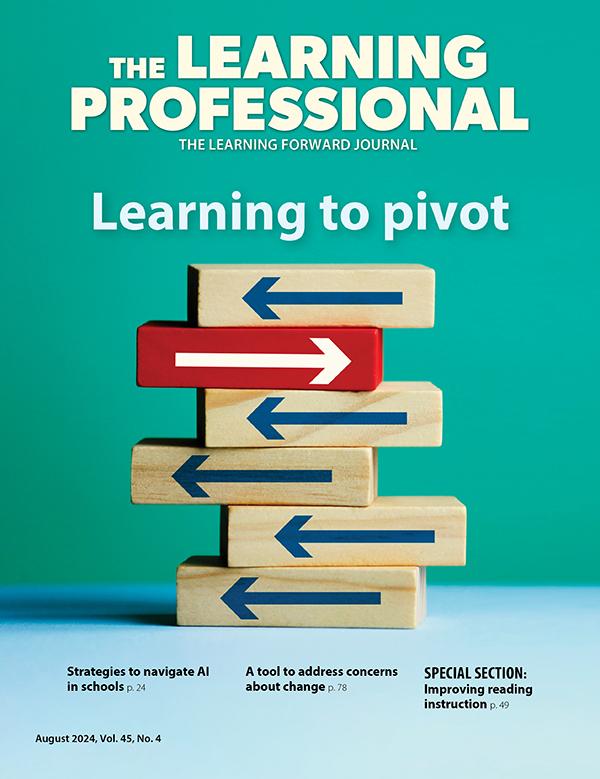Douglas Fisher (dfisher@sdsu.edu) is Chair of Educational Leadership at San Diego State University.
LEADERSHIP TEAMS
Strong teams start with collective vision and early wins
By Jody Spiro and Douglas Fisher
Categories: Continuous improvement, Leadership, Learning communitiesFebruary 2024
In summer 2023, we shared an overview of why leadership teams are important for school success on Learning Forward’s blog (Spiro & Fisher, 2023). We are pleased to have the opportunity to write a recurring column for The Learning Professional to explore leadership teams in more depth, focusing on what makes them successful.

Strong leadership teams are an important way that site leaders accomplish their goals. Leaders cannot make every decision or direct every action within their school, much less teach all the students. Leadership teams spread the workload and responsibility among a wider group of people and create feedback loops for ongoing communication and consistency.
Two foundational elements for developing leadership teams are setting a collective vision and establishing an early win to demonstrate the feasibility of achieving the vision.
The collective vision is an agreed-upon definition of what the team should accomplish. When all team members have a clear and consistent vision, they are more likely to allocate their time and effort toward accomplishing what is most important. Conversely, when teams do not have a shared understanding, members may be at odds with one another’s goals.
Teams should be able to clearly and succinctly answer questions such as:
- Why does this team exist?
- What are our priorities?
- What commitments do we make?
- What do we want to achieve as a team?
- How does our vision align with the school (and/or district’s) vision?
Doing so is an important aspect of collective efficacy, but one that is often missed. Collective efficacy is not simply believing in the team’s ability to do good things, but drawing on evidence that the team is increasingly successful in reaching goals.

To demonstrate this success, teams need to monitor their progress toward reaching goals. A tool that can assist with this is an early win — a concrete, observable result achieved in a short time that contributes to ultimately accomplishing the larger vision. An early win demonstrates that the vision is feasible and likely to result in benefits for those involved.
Having an early win helps everyone see that they are on an effective path. It establishes momentum and builds confidence among team members and the entire community.
If the team waits until it can document full success in achieving the vision, there may be too long a gap between setting the vision and seeing results, leading the team and the community to lose faith that the vision can be accomplished.
For example, if the team has a vision of dramatic improvement in student achievement, boosting standardized test scores will not occur overnight. But steps such as documenting and reviewing students’ classroom work to gauge progress can help ensure the work is starting to make a difference and bolster the team’s and community’s confidence that they are on the right track.
The early win must be carefully designed for maximum effect. Here are important characteristics of an early win that the leadership team should consider when planning:
- Perceived by the team as furthering the achievement of the vision. Achieving a win just to have a success means little if it doesn’t move the vision forward. The vision should always undergird the work.
- Tangible and observable within a few weeks. The leadership team needs to define specifically what work will be undertaken and when.
- Symbolic of a shared value. When the school and district community perceive the win as furthering their values, it will ultimately become part of the culture. This will help create the kind of lasting improvements sought by the leadership team.
Celebrating early wins is important, not just for the leadership team but for the community as a whole. This step is too often overlooked. Planning ahead with milestones, deadlines, and opportunities for sharing results can help.
At the same time, when looking at early results, the team can learn from what isn’t working and engage in continuous improvement processes to get on track. The team can never know everything up front, and a “learn as you go along” approach is important.
Here are some examples of ways leadership teams can establish early wins:
- Do a values clarification exercise to find out what is most important to the team, faculty, and students to form the foundation of the vision. Build next steps, including professional learning, around those values.
- Create subject-area teams that engage in 45-day continuous improvement cycles to review student achievement and evidence of progress, and plan accordingly for the next 45 days. Design each cycle’s goals to be achievable in the allotted time frame to encourage wins that build momentum and lead to further wins.
- Engage teachers in peer observations through classroom visits. Use a short, standard protocol for observation and documentation. Create opportunities for participating teachers to present their learning to the leadership team and faculty and use the insights to spread best practices or revise practices and processes as needed. Some districts organize visits across schools and include central office staff to encourage learning and shared understanding throughout the district.
Communication between the leadership team and the school community should occur early and often. The team’s vision and early wins — as well as future steps — should be transparent to the entire school community and reflect the community’s larger values.
Categories: Continuous improvement, Leadership, Learning communities
Recent Issues
BUILDING BRIDGES
December 2024
Students benefit when educators bridge the continuum of professional...
CURRICULUM-BASED PROFESSIONAL LEARNING
October 2024
High-quality curriculum requires skilled educators to put it into...
LEARNING TO PIVOT
August 2024
Sometimes new information and situations call for major change. This issue...
GLOBAL PERSPECTIVES
June 2024
What does professional learning look like around the world? This issue...














